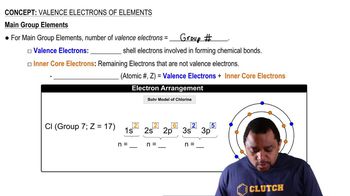Here are the essential concepts you must grasp in order to answer the question correctly.
Effective Nuclear Charge (Zeff)
Effective Nuclear Charge (Zeff) is the net positive charge experienced by an electron in a multi-electron atom. It accounts for the actual nuclear charge (the number of protons) and the shielding effect caused by other electrons. The greater the Zeff, the stronger the attraction between the nucleus and the outermost electrons, influencing their energy levels and chemical behavior.
Recommended video:
Shielding Effect
The shielding effect refers to the phenomenon where inner electrons partially block the attractive force of the nucleus on outer electrons. This results in a lower effective nuclear charge felt by the outer electrons. In calculations, core electrons typically contribute a fixed value to the screening constant, while valence electrons contribute less, reflecting their proximity to the nucleus.
Recommended video:
Valence and Core Electrons
Electrons in an atom are categorized as valence or core electrons. Valence electrons are those in the outermost shell and are involved in chemical bonding, while core electrons are located in inner shells and do not participate in bonding. Understanding the distinction between these two types of electrons is crucial for calculating Zeff, as they contribute differently to the shielding effect.
Recommended video:
Main Group Elements Valence Electrons
 Verified step by step guidance
Verified step by step guidance


